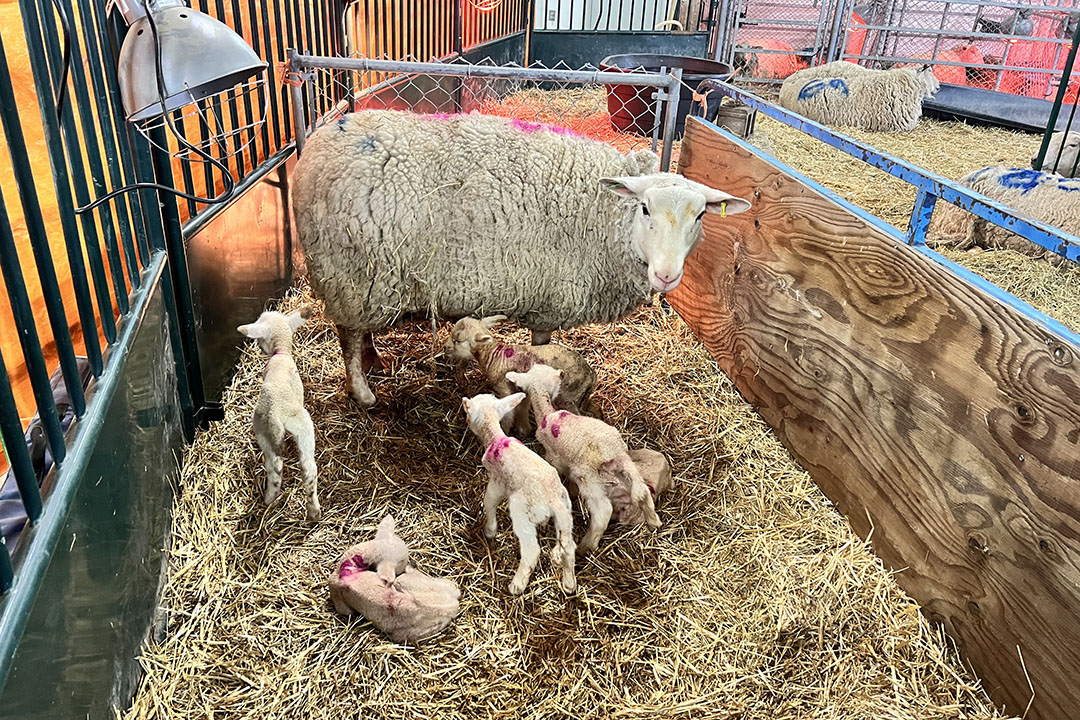
USask veterinary students involved in rare lambing of sextuplets
A group of fourth-year veterinary students at the University of Saskatchewan (USask) had an exciting surprise on March 21 when they discovered that one of the ewes in their care had delivered six healthy lambs.
By WCVM Today“She’s only a three-year-old ewe. Looking at her size, we thought she would have quads (four lambs) and we were sort of ready for that,” says Dr. Dinesh Dadarwal (BVSc&AH, PhD), an assistant professor at the Western College of Veterinary Medicine (WCVM).
“And then early in the morning, the students texted me: ‘Number 66H had six.’”
Dadarwal says he initially thought that another ewe’s lambs had somehow joined the newborns. But once it was confirmed that all six of the lambs — each weighing about two kilograms — belonged to the same mother, everyone grew excited.
“The lambs were all alive and with no stress at all seen on them. And I said, ‘Okay! She’s a supermom!’” says Dadarwal.
The ewe has also been exceptional when it comes to feeding her lambs. The WCVM students were able to ensure that all six lambs had nursed and received enough colostrum, the ewe’s first milk that contains vital nutrients and antibodies. One or two of the lambs needed some supplemental feeding until they reached three weeks of age. Over the last seven to 10 days, four lambs have also received some supplemental feed. But overall, all six of the lambs have been thriving.
While multiple births are common in sheep, Dadarwal says sextuplets are still considered rare. In addition to the sextuplets, Dadarwal says 20 of the college’s 21 ewes had multiple births this year, ranging from twins to quadruplets.
For the first four weeks, the ewe and her lambs were housed in a “jug” inside a covered shelter. They recently joined the rest of the lambed ewes in a common pen.
“I was worried that if I let her go outside early, she might lose track of her lambs,” says Dadarwal, adding that this is only the ewe’s second lambing.
“But her mom is still in the flock, and I’ve watched them both with their lambs, and their behaviour is pretty much the same. They’re really good moms, and whenever they go out to feed, they keep all their lambs right behind them.”
A reproduction specialist, Dadarwal works with senior veterinary students during the annual two-week neonatal rotation focusing on sheep and goats. Drs. Fritz Schumann (DVM) and Kamal Gabadage (BVSc), clinical associates in the WCVM’s Ruminant Field Service, and Dr. Fabienne Uehlinger (DVM, PhD), associate professor and internal medicine specialist, are also involved in training the students and caring for the animals.
The clinical rotation allows veterinary students to gain hands-on experience with pregnant sheep and goats before they enter veterinary practice later this spring.
This year has been an exceptional one for the WCVM flock in which 21 ewes have birthed 70 lambs — a birthing rate of over 300 per cent. Dadarwal says that the surprising statistics result from a combination of factors that include genetics, diet and hormones.
The flock consists of Rideau Arcott-cross sheep, a Canadian breed known to be prolific. Before the ewes ovulate, Dadarwal says they’re fed a diet with elevated nutrition that optimizes ovulation, conception and embryo implantation rates. The veterinary team also gives the ewes a specific hormone protocol that stimulates follicle growth and results in multiple embryos.
While the fourth-year students have studied the theories and practices behind small ruminant reproduction, the neonatal rotation provides a practical chance for them to see first-hand the behavioural and psychological changes that occur in the mothers before and after they give birth.
Students participating in the rotation are required to have taken at least two food animal-related elective courses in their third year of the veterinary program to ensure that they have a significant interest in food animals.
Dadarwal has been involved with the small ruminant neonatal rotation since its inception in 2018 when the college’s first flock of eight ewes gave birth to 13 lambs.
“This rotation has given us many opportunities, not only for the students, but with the sheep producers in Saskatchewan. Plus, our sheep have helped us to attract research funding from the Saskatchewan Ministry of Agriculture,” says Dadarwal. “We have been able to work closely with the Saskatchewan Sheep Development Board because of our flock.”
